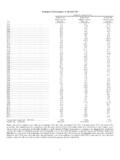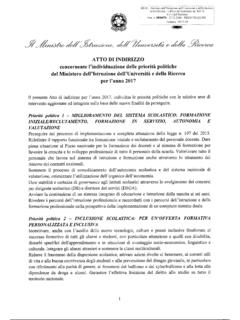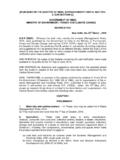Transcription of UNICEF The State of the World's Children 2016
1 A fair chance for every child The State of The World's Children 2016aCKnoWledGeMenTSThis report is the result of collaboration among many individuals and institutions. The editorial and research team thank all who gave so willingly of their time, expertise and energy, in particular:Advisory Board: Yoka Brandt, Deputy Executive Director; Geeta rao Gupta, Deputy Executive Director; Gerard Bocquenet, Ted Chaiban, Sarah Cook, Paloma escudero, andres franco, Claudia Gonzalez romo, Goran holmqvist, Karin hulshof, afshan Khan, olav Kj rven, Jeffrey o and Policy Guidance: abdul alim, david anthony, ivelina Borisova, Josephine Bourne, nicola Brandt, Jingqing Chai, Kim dickson, Martin evans, antonio franco Garcia, Vidhya Ganesh, Katherine holland, Tamara Kummer, George laryea-adjei, dheepa Pandian, david Stewart, Morgan Strecker, Guy Taylor, Justin Van fleet, rudina Vojvoda, frank Borge Wietzke, alexandra Yuster, Maniza you to rachel Sabates-Wheeler and Jennifer Yablonski for the background paper, Social protection and child poverty: evidence, practice, and gaps , and to Gonzalo fanjul for the background paper Child poverty and inequality in rich countries.
2 Thank you to ravneet ahluwalia and Vivek Kumar for their help with the Perspective essays. Communication team: Justin forsyth, Deputy Executive Director; Paloma escudero, Director, Division of Communication; edward Carwardine, Deputy Director, Division of Communication; Maurico aguayo, nigina Baykabulova, Gerrit Beger, Penni Berns, Marissa Buckanoff, Patricia Codyre, eliana drakopoulos, Jedd flanscha, Claudia Gonzalez romo, Bayann hamid, Chulho hyun, angus ingham, Malene Jensen, Ueli Johner, ariel Kastner, nicholas ledner, Marixie Mercado, najwa Mekki, Christine nesbitt, david ohana, rebecca obstler, laetitia Pactat, Katarzyna Pawelczyk, hugh reilly, abhijit Shanker, Melanie Sharpe, arissa Sidoti, Tanya Turkovich, Sonia country and regional offices and headquarters divisions contributed to this report by taking part in formal reviews or commenting on drafts. Many field offices and UNICEF national committees arranged to translate or adapt the report for local use.
3 RePorT TeaMEDITORIAL AND RESEARCH Kevin Watkins, principal author; Maria Quattri, research and technical advice on data; Tara dooley, hirut Gebre-egziabher, anna Grojec, Yasmine hage, Catherine langevin-falcon, Timothy ledwith, C line little, Baishalee nayak, Carlos Perellon, ami Pradhan, Charlotte rutsch, Zahra Sethna, Jordan AND ANALYTICS agbessi amouzou, robert Bain, nassim Benali, david Brown, Claudia Cappa, liliana Carvajal, Karoline hassfurter, hiroyuki hattori, lucia hug, Priscilla idele, Claes Johansson, Julia Krasevec, Vrinda Mehra, Padraic Murphy, Colleen Murray, Khin Wityee oo, nicole Petrowski, Tyler Porth, Shahrouh Sharif, Tom Slaymaker, Chiho Suzuki, haogen Yao, danzhen AND DISSEMINATION Samantha Wauchope, Production Specialist; Germain ake, ernest United nations Children s fund ( UNICEF )June 2016 Permission is required to reproduce any part of this publication. Permissions will be freely granted to educational or non-profit organizations.
4 Others will be requested to pay a small fee. Please contact: division of Communication, UNICEF attn: Permissions 3 United nations Plaza, new York, nY 10017, USa Tel: +1 (212) 326-7434 email: the latest data, please visit < >. iSBn: 978-92-806-4838-6 Publication and graphic designSoapbox, infographics on pages 3, 11, 42, 70 and fair chance for every child The State of The World's Children 2016iiTHE State OF THE world S Children 2016 ContentsThe State of the World's Children by Anthony Lake , Executive Director, UNICEF vi Why focus on equity now? 3 Meeting the equity imperative 5 Patterns and risks of child mortality 10 Prospects for child survival 12inequities in child survival 13disparities in access and quality of care 20low-cost interventions can make a difference 21reaching the most vulnerable 21 What if the gaps are not closed? 24equity objectives 26high return on health investments 26 Benefits of universal health coverage 29adequate and equitable financing 34 Power in partnerships 37forewordIntroduction01 Child health: a fair start in lifepages 8 39reaching every child: The promise of equitypages viii 7iiiTHE State OF THE world S Children 201602education.
5 Levelling the playing fieldpages 40 67access to education from the start 42equity and learning outcomes 46education in emergencies and protracted crises 52 Benefits of quality education 55reaching Children throughout the learning process 56equity targets 59 Teaching matters 60education financing 61 The role of aid 62equitable progress is possible 64 The effects of poverty in childhood 70 Measuring how many Children live in poverty 71 Children living in extreme poverty 72 Children living in moderate poverty 75 Poor Children living in rich countries 75 Child poverty in all its dimensions 78disadvantages overlap and reinforce one another 78 Universal measurement of child poverty 80 The role of cash transfers in reducing poverty and inequality 81 Cash transfers and access to essential services 83expanding social protection and looking ahead 84information 90integration 92innovation 94investment 97involvement 990304 Children and poverty: Breaking the vicious cyclepages 68 87 Pathways to equitypages 88 101 Contents, continuedivTHE State OF THE world S Children 2016 BoX 1.
6 Equity defined 7 BoX female volunteers help health workers reach the marginalized in nepal 23 BoX every child counts: The importance of quality data on child survival 27 BoX Bangladesh shows the challenge of sustained progress in child survival 35 BoX health equity funds provide free health care to the poor 36 BoX eliminating malnutrition can help break the cycle of unequal opportunity 36 BoX The developing brain: an early window of opportunity for learning 50 BoX The destructive impact of armed conflict on education 53 BoX Brazil and Viet nam: Making the grade 63 BoX : Monetary child poverty measures 72 BoX Measuring multidimensional child poverty 74figure Countries with limited economic growth can still reduce child mortality 13figure Progress in under-five mortality does not necessarily come with greater equity 14figure The poor will need to make faster progress to reach the 2030 goal 15figure Progress must accelerate for the least advantaged Children 18figure accelerated progress in neonatal mortality is key to meeting the SdG target 22figure Many
7 Countries will miss the under-five mortality target, some by a wide margin 25figure antenatal care and skilled birth attendance save newborn lives 29figure in 63 countries, equity in intervention coverage could reduce under-five mortality rates by almost 30 per cent 30figure Many countries do not have enough health providers 32figure More than half of the 59 million out-of-school Children live in sub-Saharan africa 44list of BoxesPerspectivesendnoteslist of figuresContents, continueda fair chance for girls end child marriage by Ang lique Kidjo 38 Give Children a chance by Gordon Brown 66 What are we waiting for?
8 Sustainable societies begin with Children by Kailash Satyarthi 86 102vTHE State OF THE world S Children 2016figure if current trends persist, the world is off-track to reach primary and secondary education for all by 2030 45figure Many girls and boys drop out as they transition through education levels 45figure in Pakistan, the level of education achieved depends on gender, residence and wealth 47figure Wealth, gender and residence affect education in nigeria 48figure Wealth-based gaps in basic math skills start early and persist over time 49figure early childhood education gaps vary by wealth and residence 57figure Progress must accelerate for the least advantaged Children 58figure a disproportionate share of Children live in extreme poverty 73figure in 2030.
9 9 out of 10 Children in extreme poverty will live in sub-Saharan africa 74figure More than half of the population in low- and middle-income countries live on less than US$5 a day 76figure in most european Union countries, Children are at higher risk of monetary poverty than adults 77overview 108 General note on the data 108 Child mortality estimates 109 Under-five mortality rankings 110regional classification 112notes on specific tables 113 Table 1. Basic indicators 118 Table 2.
10 Nutrition 122 Table 3. health 126 Table 4. hiV/aidS 130 Table 5. education 134 Table 6. demographic indicators 138 Table 7. economic indicators 142 Table 8. Women 146 Table 9. Child protection 150 Table 10. The rate of progress 154 Table 11. adolescents 158 Table 12. disparities by residence 162 Table 13. disparities by household wealth 166 Table 14. early childhood development 170 Statistical Tablespages 107 172 Contents, continuedviTHE State OF THE world S Children 2016 The State of the World's childrenforeWordinequity imperils millions of Children and threatens the future of the worldas we look around the world today, we re confronted with an uncomfortable but undeniable truth: Millions of Children s lives are blighted, for no other reason than the country, the community, the gender or the circumstances into which they are born. and, as the data in this report show, unless we accelerate the pace of our progress in reaching them, the futures of millions of disadvantaged and vulnerable Children and therefore the future of their societies will be imperilled.














